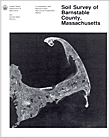The following is a map unit description from the "Soil Survey of Barnstable County, Massachusetts (Fletcher, 1993)" for more information contact the USDA-NRCS http://nesoil.com/barnstable or

CoD-Carver-Hinesburg loamy coarse sands, hilly.
These hilly and steep, very deep, excessively drained and well drained soils are on side slopes, ridges, and hills in areas of ice-contact deposits. Slopes range from 15 to 35 percent. The soils make up about 0.1 percent (347 acres) of the survey area. They are mapped mainly in the Carver-Hinesburg-Nantucket general soil map unit. Areas are irregular in shape and generally range from 5 to 40 acres in size. They are about 45 percent Carver soil, 20 percent Hinesburg soil, and 35 percent other soils. The soils occur as areas so intricately mixed or so small that separating them in mapping is not practical.
Typically, the surface of the Carver soil is covered with an organic layer. This layer is about 2 inches of loose, undecomposed pine needles, leaves, and twigs and 1 inch of matted, partly decomposed and well decomposed organic material. The surface layer is light brownish gray, very friable loamy coarse sand about 3 inches thick. The subsoil is coarse sand about 33 inches thick. The upper 10 inches is strong brown and very friable, the next 9 inches is yellowish brown and very friable, and the lower 14 inches is brownish yellow and loose. The substratum to a depth of 65 inches or more is light yellowish brown, loose coarse sand.
Typically, the surface layer of the Hinesburg soil is dark brown, very friable sandy loam about 1 0 inches thick. The subsoil is about 22 inches thick. It is yellowish brown, very friable loamy coarse sand in the upper 12 inches and light olive brown, very friable loamy sand in the lower 10 inches. The substratum extends to a depth of 65 inches or more. It may be mottled. It is light brownish gray, friable fine sandy loam in the upper 6 inches and light olive brown, firm sandy clay loam in the lower part.
Included with these soils in mapping are small areas of Hinckley, Nantucket, and Plymouth soils, small areas where slopes are less than 15 percent, and a few areas where stones are on the surface. Also included are areas where the Hinesburg soil is underlain by sandy and gravelly material below a depth of 60 inches. Included areas make up about 35 percent of this unit.
Permeability is very rapid in the subsoil and substratum of the Carver soil. Available water capacity is very low. The soil is droughty in late summer. Depth to the seasonal high water table is more than 6 feet.
Permeability is rapid in the subsoil of the Hinesburg soil and moderately slow in the substratum. Available water capacity is moderate. Depth to the seasonal high water table is generally more than 6 feet.
Most areas are used as woodland. These soils are generally unsuited to cultivated crops, hay, and pasture because of the low available water capacity, the slope, and a severe hazard of erosion.
These soils are poorly suited to woodland. The droughtiness and the slope are limitations affecting woodland management. Operating equipment may be hazardous on the steeper slopes. Removal or control of competing vegetation helps to obtain the best growth of newly established seedlings. The most common trees are pitch pine, white oak, scarlet oak, and black oak.
The slope is a limitation it these soils are used as sites for buildings. Extensive land shaping is generally needed. Buildings and lots should be designed so that they conform to the natural slope of the land. Erosion is a severe hazard during and after construction. Planting well suited grasses as soon as possible after the surface is disturbed minimizes the erosion hazard. The droughtiness of the Carver soil is a limitation affecting lawns and shallow-rooted trees and shrubs. Adding a layer of topsoil and frequently watering during dry periods help to overcome this limitation.
These soils are limited as sites for septic tank absorption fields because the Carver soil may not adequately filter the effluent and the Hinesburg soil does not readily absorb the effluent. Because of the poor filtering capacity, the pollution of ground water is a hazard. In areas where the Hinesburg soil is underlain by sandy and gravelly material, excavations that extend to this material generally can overcome the restricted permeability. The slope is an additional limitation. It can be overcome by installing the distribution lines on the contour or in areas that were graded during construction of the dwelling. Onsite investigation is needed to determine the suitability of a given area and the measures needed to overcome the limitations.